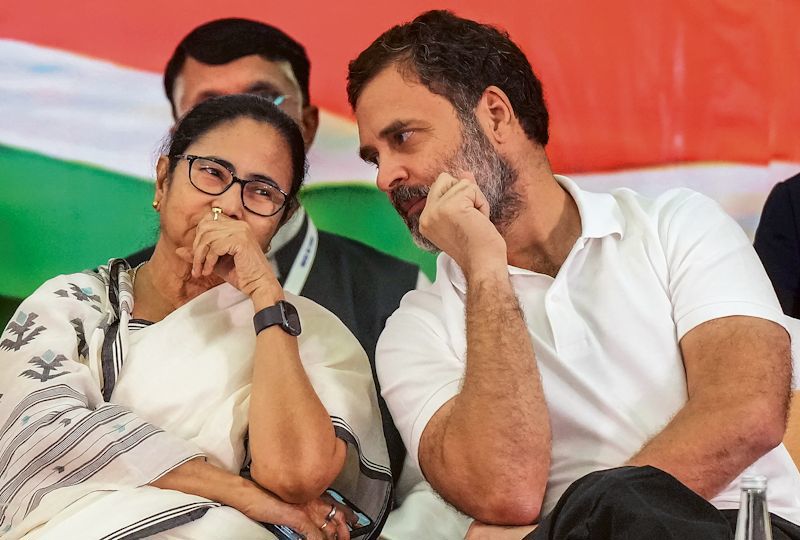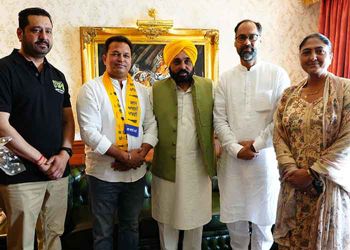
Dicey: The TMC and the Congress united against the Left Front in the 2011 West Bengal Assembly elections. However, they are going their separate ways in the upcoming Lok Sabha polls in the state. PTI
Atanu Biswas
Professor, Indian Statistical Institute, Kolkata
INDIA witnessed the dawn of coalition politics at the Centre when the Janata dispensation led by Morarji Desai took charge in 1977. Subsequently, several multi-party governments have ruled the country.
In general, it makes sense for some coalitions to exist, given the shared interests of their constituents. Some electoral alliances appear a bit tricky, though. Take the example of West Bengal. The Trinamool Congress (TMC) and the Congress united against the then ruling Left Front in the 2011 Assembly elections; five years later, the Left Front and the Congress formed an alliance against the ruling TMC. Many political analysts expressed concern when the Left and the Congress formed a pre-election coalition with the newly formed Indian Secular Front in the 2021 Assembly elections. In Indian politics, there are neither permanent friends nor permanent enemies. “Constituent members regularly switch sides depending on the whims of their party leaders, state-specific policy concerns and sheer political expediency,” Milan Vaishnav and Jamie Hintson wrote in the context of the 2019 Lok Sabha elections.
However, does an alliance inevitably result in an increase in the political parties’ vote share and number of seats? In a coalition, vote shares are typically not additive. In the context of the aforementioned West Bengal Assembly elections, there are still many experts who question whether the alliance with the Congress in 2011 helped the TMC, or if it helped the Left in 2016. Furthermore, the Left Front is still reeling from the 2021 election debacle.
The term ‘coalition’ is derived from the prefix ‘co-’ (‘together’) and the Latin verb ‘alescere’ (‘to grow’). A coalition should, thus, be judged by how the participating parties benefit from it. There is a growing body of research in economics, especially in the field of game theory, on coalition formation, which is the process by which one or more ‘coalitions’ consciously come together to decide on actions as a group. Players establish alliances, break them up later, and even reform in shifting alliances, all the while reaping ‘payoffs’ (according to them) based on the coalition structure prevailing at the moment. Both the cooperative game theory and non-cooperative bargaining models are applied.
Numerous studies have been conducted to comprehend the ways in which pre-poll coalitions influence voting behaviour in different countries. A 2020 research paper titled ‘How do coalition signals shape voting behaviour? Revealing the mediating role of coalition expectations’, which was published in the journal Electoral Studies, makes a reference to a survey experiment carried out during Sweden’s 2018 general election.
According to a recent paper published in Nature titled ‘Pre-electoral coalition agreement from the Black-Scholes point of view’, political parties can be regarded as companies whose value depends on the percentage of the population supporting a party. To study the dynamics, D Mitrovic of the University of Vienna drew an analogy with option modelling, where the stock price behaves similarly to the voters’ support. The June 2023 elections in Montenegro were elaborated as per this model.
Conditions in India, though, might be different. When election time arrives, leading national parties invariably calculate the election math in unique ways to form a winnable coalition. The strategists might differ in their approaches and, typically, the masses are unaware of the details.
In general, how would one comprehend that a coalition would be effective? It is never easy. Assume that five political parties — say P, Q, R, S and T — are competing in a constituency. Their possible vote shares are 33 per cent, 26 per cent, 7 per cent, 23 per cent and 11 per cent, respectively. In the event of no coalition, P ought to win handily. Let us now assume that Q and R have formed a coalition. If, in effect, their votes are simply totalled, it would be a tight contest between P and Q+R. However, a coalition doesn’t guarantee that the votes will be added straight. The coalition may unnerve certain voters. For example, some Q supporters may not want to vote for an R candidate running in their constituency, and vice versa. Because of this, Q+R’s total vote share may become substantially lower than P’s. Then again, a percentage of S or T voters may cast ‘strategic votes’ in support of P, increasing the likelihood that P will win. One should remember that sometimes, no coalition may be better than one. Alternatively, voters may experience a ‘bandwagon effect’ or a wave of support for the Q+R coalition, which would lead to a significant win for the combine. Therefore, it is crucial to comprehend how the coalition affects poll prospects, even though doing so is quite difficult.
Thus, by estimating the expected number of seats of Q+R alliance and the seats Q and R can win in the absence of an alliance, one can attempt to gauge whether an alliance would work. It’s also possible to estimate how an alliance will impact the number of seats won by opposing parties. A thorough analysis conducted in such a complex setup could have enormous hidden political benefits. Undoubtedly, political parties conduct such studies to shape their game plans. Nevertheless, it is a complex topic as to how the political parties would generally find the best estimates for their goals under a variety of circumstances.
The straightforward answer might be that carefully crafted survey designs, optimal statistical modelling and efficient data analyses could be helpful in this regard. But for such a process to be effective, one requires professionals with both statistical and political expertise.
Join Whatsapp Channel of The Tribune for latest updates.




























